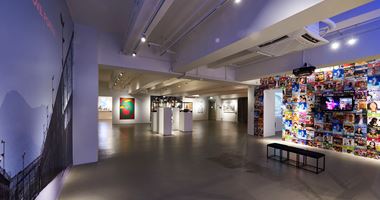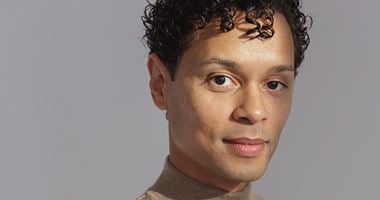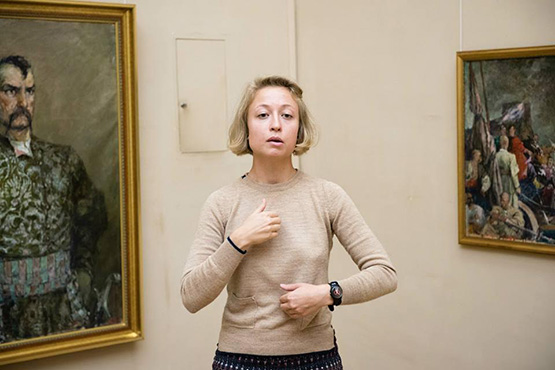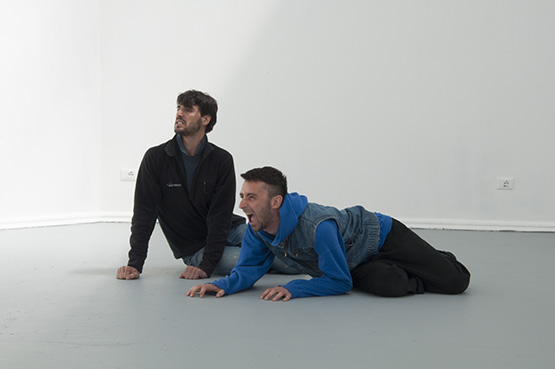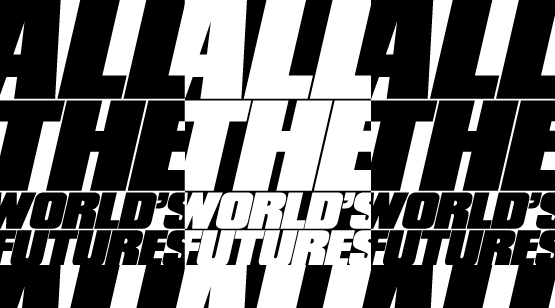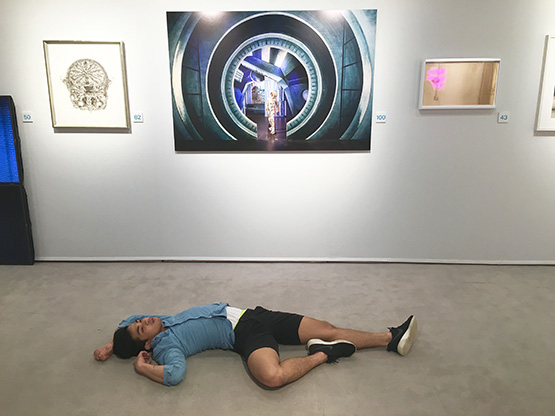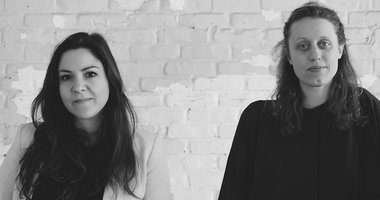Manuel Pelmuş
Cosmin Costinas and Manuel Pelmuș at Para Site, Hong Kong. Photo: Diana d'Arenberg.
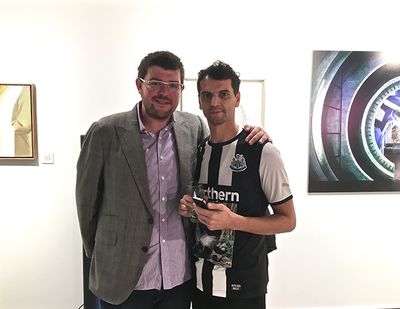
Cosmin Costinas and Manuel Pelmuș at Para Site, Hong Kong. Photo: Diana d'Arenberg.
If the name isn't immediately familiar to you, his work may be. Bucharest-born Pelmus, along with collaborator and compatriot Alexandra Pirici, was responsible for one of the standout pavilions at the 2013 Venice Biennale, Romania's An Immaterial Retrospective of the Venice Biennale.
Pirici's and Pelmuş' presentation at Venice took place in an empty white Romanian pavilion room containing nothing but a group of performers dressed in casual attire who (on a continuous revolving basis) enacted works from past biennales (for the duration of the Biennale).
What Pelmuş did was to turn art into an experience, revitalising and animating static artworks, bringing to life a subjective (and by no means exhaustive) history of modern art. It was an attempt to reclaim, recontextualise and de-monumentalise the original art works. The work opened up the Romanian pavilion—Balkanised and shunted to the outskirts of the Giardini along with a couple of other Eastern European countries; an EU economic disaster; and Austria—to the world and to history.
Among the crowd of familiar faces sipping champagne at Para Site's fundraising auction preview late last year, a young man lay on the ground in the middle of the Bonhams' exhibition space. Rolling around on the carpet, he would mutter, to no one in particular, 'Work is a disease—Karl Marx.' In the white noise chatter about art prices or the investment value of Birkin bags, this wasn't your usual Hong Kong declaration.
Maybe he was a Parisian on strike? Or did I just walk in on a performance art work? Nowadays, the distinction between art and you know, life, can be difficult to make. I once mistook an installation of jellybeans as a snack at an art fair; threw my empty coffee cup into what I assumed was a trash can, but was in fact a sculpture; and dismissed a depressed looking skinhead fondling his exposed genitals in Regent's Park as a Frieze performance art work.
What Pelmuş did was to turn art into an experience, revitalising and animating static artworks, bringing to life a subjective history of modern art.
What I was witnessing in the new Bonhams' space, in fact, was a live enactment of conceptual Serbian artist, Mladen Stilinović's 1978 Artist at Work photo series.
The original series depicting the artist lying down on a bed, fully clothed, in daylight, is a scenario which can pretty much sum up the life of a writer, but is instead intended as an ironic commentary on capital, creativity and work.
The performance at Bonhams was at the instigation of Romanian choreographer and conceptual artist, Manuel Pelmuş, whose re-presentation of Stilinovic's work questions issues of artistic work, value and materiality.
Pelmus, scruffy haired and dressed in a Newcastle United Football Club uniform bearing a needlepoint patch of pandas on the front, was not the performer at Bonhams, but he stood on the side watching the reaction of audience members, like a slightly confounded and out of place impresario.
With a new project in the pipeline for February at the Tate Liverpool, Pelmuş chats to me at the Para Site auction preview in Hong Kong about performance art, dance, a post-work society.
There is still a gap, I guess, but as you bring more work to the pubic that they're not used to, they open up to different modes of art.
DAYou started out as a dancer. Was this something you always wanted to do?
MPIt all started in Romania when it was still under the Ceaușescu communist regime. The dancing was very much a product of circumstances actually; a family friend, who used to be a ballet dancer, suggested I try it.
At the end of the '80s it was getting darker and more difficult in Romania, and my family thought this could be one career in which if you made it you could leave the country. You had a way out.
Later on I got into a dance school. After I graduated I got a scholarship and went to Hamburg to study and joined a company. So I did professional dancing for a while, but I wanted something else. Dance companies promote their own structure. It was quite big and hierarchical, and I felt like I wanted to do more of my own thing.
So when I stopped working in Hamburg I began travelling and taking different workshops, and collaborating. I was more independent, and I started doing some contemporary dance pieces on my own, and that felt better. But it was more theatre pieces, not 'art' pieces.
I'm trying to say that you don't always have to have this eight hours a day of labour.
DAHow does choreographing more conventional dance differ from choreographing a performance piece? You're not restricted by space as you are in a traditional theatre set up, and your relationship with the audience also changes, doesn't it?
MPI got interested a while ago, in Bucharest, in the dance performances we were doing. We were experimenting and trying different formats, so it wasn't always such a conventional set up.
In 2007 I did a piece entirely in the dark. The audience would never see me so the visual experience was cancelled out.
So I was trying to transgress a bit into something else, into other forms, and I got the chance to be part of an exhibition—there was a performance part and an exhibition part—so I chose to be part of the exhibition and try to do ... I don't really call it performance because I have a problem with calling it that. Historically, you understand true performance as something that starts and ends at a certain time.
It starts at 6pm and finishes at 7 or whatever. It exists within a certain time restriction. What I did in this exhibition was ongoing, and I prefer this type of ongoing action. You don't have a beginning or end, and people can arrive whenever they want.
You weren't locked in by linearity and you can test and play with temporality, and more modality. So you had a theatrical format, because it's performative, but at the same time it functioned very differently in an exhibition display.
Sometimes it's necessary to challenge yourself or change.
DAIs it more freeing to work in this context than in a conventional performance one?
MPIn a way, yes. I don't want to create hierarchies. At this moment for me it's more satisfying. It's a field you can have more fields in. It's not a locked in discipline; you can include video, painting, sculpture, performative works, lectures.
It's much more non-disciplinary in a way. These formats can coexist in the same display and they don't contradict each other. People can walk freely through it. That was interesting to me, and it felt quite now, quite contemporary.
DAYou challenge and play with traditional tropes in theatre, dance, and art. The performances don't take place on a stage where there is a fourth wall between the audience and the performers. What is the audience's role in your performances? Is there room for audience participation? Are they expected to actively engage or is it a more passive role?
MPI think it's not about passive or active, but they can stay for a long time, or there are people who just drop by. It's a different spectatorship. It's not better or worse.
But by choosing to go or stay they are also making an active decision? Yeah, its true, they have the freedom to choose. It's almost like editing. They can take a look at it for half, an hour, or however long. It's a very different environment.
For 10 years I have been doing a certain kind of work and it's more fresh for me to do this. Sometimes it's necessary to challenge yourself or change.
I think slowly people are getting more informed and more receptive to this type of work in Romania.
DAYou donated a work for Para Site's annual fundraiser, a performance based on Mladen Stilinovi ć''s Artist at Work. The performance work challenges the notion of materiality, and collectability. It can't be hung on a wall, although photo documentation of it can. It exists only when it is enacted. Can you tell me a little about this?
MPA central aspect of this piece is its explicit relationship to a politics of work. More precisely an explicit connection between Mladen Stilinović's reflections (at the time) on the glorification of work, the right to be lazy, artistic labour and so on, and current debates around a post-work society and a future without work, for which the first steps to be taken would be a reduction of the working hours, while still receiving a full day pay.
Of course the other aspects of the piece such as time, embodiment, memory, history, the condition of performance under economy of attention and presence, and so forth remain as important to me, only that this time and for this work there was an intentional emphasis on the politics of labour.
In this Stilinović photographic series, called Artist at Work the artist is basically sleeping. In the '70s and '90s, he wrote this manifesto in praise of laziness in which he argues that both systems—capitalism and socialism—were two sides of the same coin because they were both glorifying and praising work and productivity.
In the '70s when he did this he was thinking about what performance is, and in the end everyone must have a photo or video, you need documentation. Then he thought, why do performance in a public space at all? So, that's the catch.
Alot of people think that the photographic work of Artist at Work was the documentation of the original performance, but in truth he skipped the performance altogether. He just did the photos.
In the '60s and '70s performance art had this anti-market, anti-capitalist stance—it couldn't be repeatable, it was just a one-time performance supposed to subvert the market—but in fact those artists had to make a living and many of them went on selling documentation of their performances in order to circulate it.
He observed this quite well, and his observation was quite ironic. In terms of economy he understood how it worked, so he went straight for the photo series.
I was thinking whether there is a possibility to attach value to idleness, which is less about work, in the sense of labouring, which is the only thing that is valued and deserves value.
For the Para Site donation I thought it would be good to reverse this, to make it into a live act, to reenact it, because people think it was a performance but it never was. So you have the five photographs on the wall enacted by the performer.
At the same time there is this quotation that he utters from his manifesto, In Praise of Laziness: 'Work is a disease, Karl Marx'. But in fact the quote is not by Karl Marx, it is by Mladen. He was saying that, in the former Yugoslavia where he was living, it seemed to him—and he was being ironic—that anything that Karl Marx would say would be taken very seriously, so he decided to say this quote. I was intrigued with this quotation.
Then I thought about this auction environment. Even though this is a charity auction, still I think that with art fairs and auctions, the economic value of art is made really explicit, whereas in museums that doesn't come across so much. You look at objects and you think they are beautiful or not.
It's not that it's masked. I'm not interested in an operation of denouncing or saying something banal like there is money in the art market, because that's really boring—but it's somewhere where you see clearly how value is assessed and attached to works. It's very explicit.
So, I thought this would be an interesting place to look at a work, which proposes idleness, or as little productivity and labour as possible. The performer is basically just lying on the floor changing his position. I was thinking whether there is a possibility to attach value to idleness, which is less about work, in the sense of labouring, which is the only thing that is valued and deserves value.
So for example the instructions for the buyer, it says that the performer mustn't perform for more than three hours a day, but still they must receive a wage for the entire day. I'm trying to say that you don't always have to have this eight hours a day of labour.
DAYour work activates a lot of political, historical and economic discourse, but there's also an element of irony to it. In the case of irony, it's not mocking; it's questioning ownership. How are you going to own this?
MPThe reason that it's hard to sell or own is because the collector or the buyer cannot live with it. And this is in connection to materiality and immateriality. How does this function?
Ultimately for the art context it would have been interesting to have a combination of material objects and something else, different modalities. Instead of separating, it could be a hybrid display; it could open up a possibility to have different modalities coexisting in the same space and not so much separated.
There's the theatre, the performance programme, there's a permanent collection upstairs and theatre downstairs. So it's this [Centre] Pompidou model—which was very interesting in the '60s when it emerged—which operated on this separation, and it's a bit more porous.
DADo you think there is a conflation of art and entertainment with performance art today?
MPYeah, I would say it's more an experience economy, because it's not so much about how good that piece is, but what it performs. You get an experience from it. But yes, this is around, and I'm trying to reflect on this with my work.
DAYou have collaborated with Alexandra Pirici on a number of pieces. Do you work separately on things too? And when you do work together, how do you conceive of ideas for works?
MPIt's very simple. For Venice we collaborated on looking for material and researching together, we discussed everything.
We decided on how to proceed on aesthetics and selection for the art works to translate, often art works that produced some debate around them. But there was also this criteria of lesser known or forgotten artists. And of course we decide on works that we liked together.
In a way this history of the Venice Biennale is very subjective; we're claiming an unauthorised version of this history and proposing our own version of this history, which is very much based on things that we prefer.
And there is another aspect. It was also placed in the Romanian Pavilion, so the history of the most prestigious biennale in the art world was claimed in the pavilion of a so called less central and more peripheral country or culture.
Sometimes I feel like when you do this corrective history with all these artists who are canonised.
DAYes, I heard it being referred to as one of the Balkanised pavilions.
MPYes, exactly. There is a clear geopolitics to the Biennale, which is evident with the Giardini. You enter and you have the important countries in the centre—the United States, Germany, France, England—then you cross the bridge and you have Poland, Romania, Greece, Yugoslavia, these 'outer' pavilions.
I thought this was an interesting political gesture, to claim the history of the Biennale in the Romanian pavilion. We self-authorised to do this.
It wasn't an exhaustive history—the Venice Biennale is 105 years old, and millions of works—I don't think even they could do it. You couldn't possibly have it all. You couldn't even put it in one book
DAWhat is the role of the body in your work? It is more than just a tool through which to enact often static works? Or is the body used as a tool of critical questioning of history and collective memory?
MPThat's a good question. For example, in the case of Venice and a few other works, like [we presented] at the Pompidou, the idea was neither about glorifying or paying homage, but nor was it about parody or mocking.
When you claim this history of iconic and important works and you translate and reproduce it with the human body in this low key and simple aesthetic, you already produce an operation of de-scaling. So, that's already an opposition that exists within intention.
It produces a certain tension, and that's meant to produce a de-monumentalisation, but it really functions in between—neither glorifying nor mocking. We chose the works that we reproduced because we thought they were great.
It wasn't about being an iconoclast and tearing the works apart. But it's also sometimes about a shift, and proposing a different scale for it, and claiming and embodying history. Someone was saying that this operation of translating also does something to our relationship with the original. There is no original in a way, and it produces a different relationship with commentary too.
But we mixed lesser-known artist with more recognisable and iconic art works. It was perhaps more subversive to place them on the same level as each other.
Sometimes I feel like when you do this corrective history with all these artists who are canonised, I think it is somehow more interesting because it's not leveling out. This has an ambiguity but the fact that you don't reproduce the hierarchies, and you can have Picasso and an obscure artist, or forgotten artist, is interesting.
For Hong Kong I had a few ideas. I was initially thinking of doing something of Ai Weiwei, but then settled on Mladen because of this relationship to labour and work, particularly in the context of Hong Kong, which is a financial capital.
It seems there is a lot of focus on efficiency and productivity here; it's a business hub. At the same time the auction house here has a connection with artist names and brands and their market value. I thought this work could suggest something else.
DAYou work and live between Berlin and Bucharest. How is your work received in Bucharest compared to other cities?
MPYou have a small scene in Bucharest. But of course there are a lot of structural problems; there aren't that many spaces in which to host more critical discourse. In that sense it's also about a level of familiarity. So of course people ask, what is this, what's it doing in the pavilion? It's not a beautiful painting or sculpture.
Whereas in Berlin you have 400 galleries—some commercial, others critical and experimental—and you have museums and biennales. But, I think slowly people are getting more informed and more receptive to this type of work in Romania, particularly with information online, which is not centralised.
There is still a gap, I guess, but as you bring more work to the pubic that they're not used to, they open up to different modes of art.
DAWhat are you working on in the near future?
MPI'm hosting a series of debates in Bucharest over three months with a small organisation I started with a few friends in Bucharest called 'Caminul Cultural'.
I'm also working on an exhibition at Tate Liverpool entitled Ongoing Perishable Objects, which will be presented on the 20th and 21st of February, and is part of 2053: A Living Museum in which they [the Tate Liverpool] work with collections from several institutions.
It proposes how you can preserve works of art through memory. They want us to organise public and performers over a weekend in which all the works will be removed and we will try to represent [them] with our bodies. This will be in February.
DACan you tell me a little more about this work?
MPI will be working together with Alexandra Pirici. The work is a frame that will conclude Tate's recent exhibition, An Imagined Museum: works from the Centre Pompidou, Tate and MMK collections.
The work addresses the role of the public museum as an institution which collects, historicises and displays cultural artifacts, and will also initiate a dialogue between the artwork and the public raising questions related about history, memory and about how museums preserve and value art, now and in the future.—[O]



